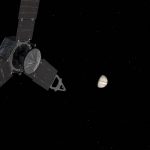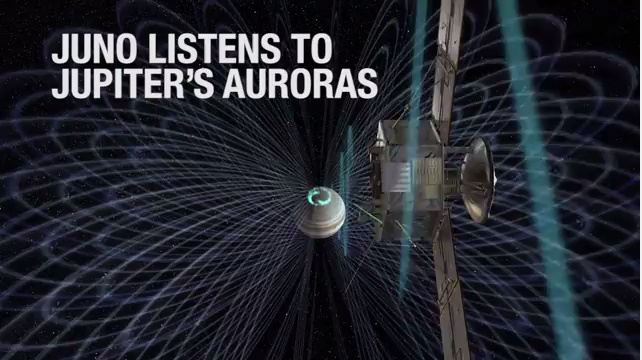2017年5月末に行われた記者会見の情報をもとに、最新の木星探査結果を3回にわたり掲載します。
今回は木星の不思議な雲(大気)についての最新画像による分析です。
今回ジュノー探査機で撮影した際、偶然にも太陽光の照射角度が最高な環境となり、かつてない詳細な雲の模様を撮影することができました。
CANDY HANSE

Credits: NASA/SWRI/MSSS/Gerald Eichstädt/Seán Doran
This sequence of enhanced-color images shows how quickly the viewing geometry changes for NASA’s Juno spacecraft as it swoops by Jupiter. The images were obtained by JunoCam. Once every 53 days the Juno spacecraft swings close to Jupiter, speeding over its clouds. In just two hours, the spacecraft travels from a perch over Jupiter’s north pole through its closest approach (perijove), then passes over the south pole on its way back out. This sequence shows 14 enhanced-color images. The first image on the left shows the entire half-lit globe of Jupiter, with the north pole approximately in the center. As the spacecraft gets closer to Jupiter, the horizon moves in and the range of visible latitudes shrinks. The third and fourth images in this sequence show the north polar region rotating away from our view while a band of wavy clouds at northern mid-latitudes comes into view. By the fifth image of the sequence the band of turbulent clouds is nicely centered in the image. The seventh and eighth images were taken just before the spacecraft was at its closest point to Jupiter, near Jupiter’s equator. Even though these two pictures were taken just four minutes apart, the view is changing quickly. As the spacecraft crossed into the southern hemisphere, the bright “south tropical zone” dominates the ninth, 10th and 11th images. The white ovals in a feature nicknamed Jupiter’s “String of Pearls” are visible in the 12th and 13th images. In the 14th image Juno views Jupiter’s south poles.
この一連の画像処理を加えた木星のカラー画像は、NASAの木星探査機ジュノーが木星を通過する際にどのくらい速く木星の見え方が変化するかを示しています。画像はジュノーカムで撮影したものです。
ジュノーは53日に1回、木星に接近し雲の上を通過しています。たった2時間で探査機は木星の北極を越えて木星本体に最接近し、その後南極を通り抜けていきます。この様子を一連の14枚の画像で示しているのがこの画像になります。
左の最初の画像は、北極がほぼ中央にあり、木星の半球全体を示しています。ジュノーが木星に近づくにつれて、水平線が動いて見える範囲の緯度は狭くなっていきます。この3番目と4番目の画像は、北極圏が視界から離れて回転しているのに対し、北半球の中緯度域では波状の雲の帯が見えてきます。5番目の画像では、乱れた雲の帯がちょうど画像の中央に来ています。 7番目と8番目の画像は、探査機が木星の赤道付近で木星に最も近い地点に到達する直前に撮影されたものです。この2枚の画像はわずか4分間隔で撮影されましたが、画像はすでに変化していました。
探査機が南半球を横断するにつれて見えてくる、明るい「南の熱帯」が9番目、10番目、11番目の画像です。木星の「真珠の弦」と名づけられた白い楕円の造形は、12番目と13番目の画像に表示されています。ジュノーは、14番目の画像で木星の南極を撮影しています。

Credits: NASA/SWRI/MSSS/Gerald Eichstädt/Seán Doran
Waves of clouds at 37.8 degrees latitude dominate this three-dimensional Jovian cloudscape, courtesy of NASA’s Juno spacecraft. JunoCam obtained this enhanced-color picture on May 19, 2017, at 5:50 UTC from an altitude of 5,500 miles (8,900 kilometers). Details as small as 4 miles (6 kilometers) across can be identified in this image. The small bright high clouds are about 16 miles (25 kilometers) across and in some areas appear to form “squall lines” (a narrow band of high winds and storms associated with a cold front). On Jupiter, clouds this high are almost certainly composed of water and/or ammonia ice.
37.8度の緯度付近に存在している雲の波は、NASAのジュノー探査機によって3次元的に雲の模様を詳細に見ることができます。 2017年5月19日5時50分(UTC)に、高度5,500マイル(8,900キロメートル)の地点から、この画像処理した元画像をジュノーカムで撮影しました。この画像は4マイル(6キロメートル)の解像度を持っています。小さな明るく輝いている高い地点の雲は約16マイル(25キロメートル)にわたっており、一部地域では「スコールライン」(寒冷前線に関連する強い風と嵐の前線)を形成するように見えます。木星では、この高い地点の雲は水やアンモニアの氷でできていることがほぼ確実です。

Credits: NASA/SWRI/MSSS/Gerald Eichstädt/Seán Doran
Close-up of enhanced-color image of Jupiter’s clouds obtained by NASA’s Juno spacecraft.
NASAのジュノー探査機で撮影した木星の雲の画像の拡大図

Credits: NASA/SWRI/MSSS/Gerald Eichstädt/Seán Doran
An even closer view of Jupiter’s clouds obtained by NASA’s Juno spacecraft.
NASAのジュノー探査機の撮影した木星の雲の更なる詳細画像

画像クリックで拡大表示(985 × 2288)
Credits: NASA/SWRI/MSSS/Gerald Eichstädt/Seán Doran
Small bright clouds dot Jupiter’s entire south tropical zone in this image acquired by JunoCam on NASA’s Juno spacecraft on May 19, 2017, at an altitude of 7,990 miles (12,858 kilometers). Although the bright clouds appear tiny in this vast Jovian cloudscape, they actually are cloud towers roughly 30 miles (50 kilometers) wide and 30 miles (50 kilometers) high that cast shadows on the clouds below. On Jupiter, clouds this high are almost certainly composed of water and/or ammonia ice, and they may be sources of lightning. This is the first time so many cloud towers have been visible, possibly because the late-afternoon lighting is particularly good at this geometry.
小さな明るく輝く雲が、NASAのジュノー探査機搭載のジュノーカムで2017年5月19日に高度7,990マイル(12,858キロメートル)から撮影した画像の木星の南熱帯地帯全体に点在しています。明るく輝いている雲はこの広大な木星の雲の中では小さく見えますが、実際には幅30マイル(50キロ)、高さ30マイル(50キロ)の雲の影を落としています。木星では、この高い地点の雲は水やアンモニアの氷でできていることがほとんどであり、雷を引き起こしていると考えられます。これほど多くの雲が濫立している様子が目に見えるようになったのはこれが初めてのことで、おそらく午後遅くの太陽光の照射がこのジオメトリに特に効果的に作用したといえます。

画像クリックで拡大表示(985 × 1118)
Credits: NASA/SWRI/MSSS/Gerald Eichstädt/Seán Doran
A close-up of the bright clouds that dot Jupiter’s south tropical zone, as seen by NASA’s Juno spacecraft.
NASAのジュノー探査機によって見ることができた、木星の南半球の熱帯地帯の明るく輝く雲の拡大画像

Credits: NASA/SWRI/MSSS/Gerald Eichstädt/Seán Doran
An even closer view of the bright clouds that dot Jupiter’s south tropical zone, as seen by NASA’s Juno spacecraft.
NASAのジュノー探査機によって見ることができた、木星の南半球の熱帯地帯の明るく輝く雲の更に拡大した画像










